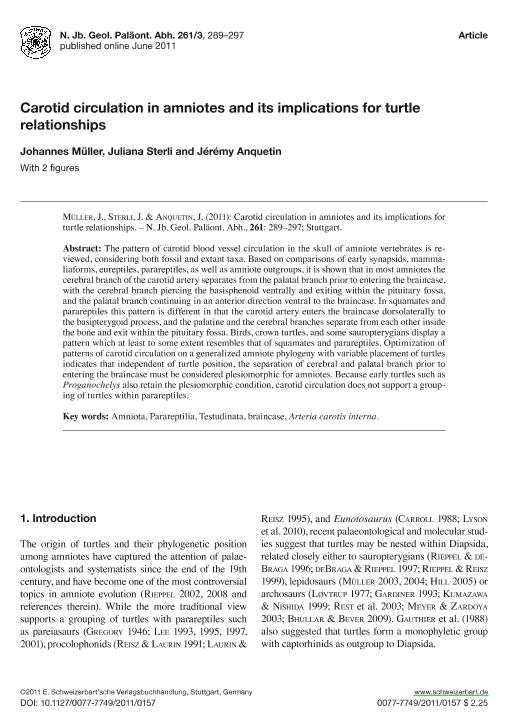Mostrar el registro sencillo del ítem
dc.contributor.author
Müller, Johannes
dc.contributor.author
Sterli, Juliana

dc.contributor.author
Anquetin, Jérémy
dc.date.available
2019-09-13T16:19:01Z
dc.date.issued
2011-09
dc.identifier.citation
Müller, Johannes; Sterli, Juliana; Anquetin, Jérémy; Carotid circulation in amniotes and its implications for turtle relationships; E Schweizerbartsche Verlags; Neues Jahrbuch für Geologie und Palaontologie - Abhandlungen; 261; 3; 9-2011; 289-297
dc.identifier.issn
0077-7749
dc.identifier.uri
http://hdl.handle.net/11336/83541
dc.description.abstract
The pattern of carotid blood vessel circulation in the skull of amniote vertebrates is reviewed, considering both fossil and extant taxa. Based on comparisons of early synapsids, mammaliaforms, eureptiles, parareptiles, as well as amniote outgroups, it is shown that in most amniotes the cerebral branch of the carotid artery separates from the palatal branch prior to entering the braincase, with the cerebral branch piercing the basisphenoid ventrally and exiting within the pituitary fossa, and the palatal branch continuing in an anterior direction ventral to the braincase. In squamates and parareptiles this pattern is different in that the carotid artery enters the braincase dorsolaterally to the basipterygoid process, and the palatine and the cerebral branches separate from each other inside the bone and exit within the pituitary fossa. Birds, crown turtles, and some sauropterygians display a pattern which at least to some extent resembles that of squamates and parareptiles. Optimization of patterns of carotid circulation on a generalized amniote phylogeny with variable placement of turtles indicates that independent of turtle position, the separation of cerebral and palatal branch prior to entering the braincase must be considered plesiomorphic for amniotes. Because early turtles such as Proganochelys also retain the plesiomorphic condition, carotid circulation does not support a grouping of turtles within parareptiles.
dc.format
application/pdf
dc.language.iso
eng
dc.publisher
E Schweizerbartsche Verlags

dc.rights
info:eu-repo/semantics/openAccess
dc.rights.uri
https://creativecommons.org/licenses/by-nc-sa/2.5/ar/
dc.subject
Amniota
dc.subject
Arteria Carotis Interna
dc.subject
Braincase
dc.subject
Parareptilia
dc.subject
Testudinata
dc.subject.classification
Paleontología

dc.subject.classification
Ciencias de la Tierra y relacionadas con el Medio Ambiente

dc.subject.classification
CIENCIAS NATURALES Y EXACTAS

dc.title
Carotid circulation in amniotes and its implications for turtle relationships
dc.type
info:eu-repo/semantics/article
dc.type
info:ar-repo/semantics/artículo
dc.type
info:eu-repo/semantics/publishedVersion
dc.date.updated
2019-08-23T18:39:55Z
dc.journal.volume
261
dc.journal.number
3
dc.journal.pagination
289-297
dc.journal.pais
Alemania

dc.journal.ciudad
Stuttgart
dc.description.fil
Fil: Müller, Johannes. Museum für Naturkunde Leibniz. Institut für Evolutions und Biodiversitätsforschung; Alemania. Universität zu Berlin; Alemania
dc.description.fil
Fil: Sterli, Juliana. Museo Paleontológico Egidio Feruglio; Argentina. Consejo Nacional de Investigaciones Científicas y Técnicas; Argentina
dc.description.fil
Fil: Anquetin, Jérémy. Muséum National d'Histoire Naturelle; Francia
dc.journal.title
Neues Jahrbuch für Geologie und Palaontologie - Abhandlungen

dc.relation.alternativeid
info:eu-repo/semantics/altIdentifier/doi/http://dx.doi.org/10.1127/0077-7749/2011/0157
dc.relation.alternativeid
info:eu-repo/semantics/altIdentifier/url/https://www.ingentaconnect.com/openurl?genre=article&issn=0077-7749&volume=261&issue=3&spage=289
Archivos asociados
